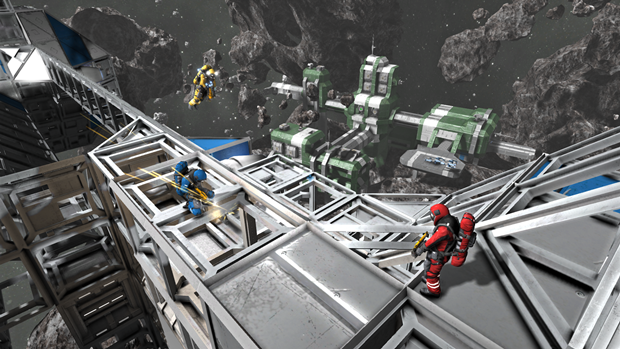
Upon first glance Space Engineers appears to be a title of exploration, creation and wonders. It allows every kid who dreams of being an astronaut live out his or her dream. However, after a lengthy tutorial and applying what I thought I had learned from that session into the game, I was correct with my initial presumptions about the game but failed to comprehend how much more the game actually offered.
But while the game is without a doubt enjoyably overwhelming it did at times feel contradictory to actually being a “game”. I couldn’t tell if I was playing a game or working with a piece of computer software. Thankfully this part of my experience with the game only lasted for the first hour, as I came to grips with the game’s mechanics and how to play.
"However, after a lengthy tutorial and applying what I thought I had learned from that session into the game, I was correct with my initial presumptions about the game but failed to comprehend how much more the game actually offered."
While this didn’t necessarily detract from the experience of being an astronaut, or an engineer in space. It felt more simulation than it did an actual game. Despite my time with the game and the nature of patience that the game requires the large audience that it could potentially gain is one not to be underestimated.
So what is Space Engineers exactly? It’s a game that allows you to build your own space stations, constructs, and space ships, through the means of resource management, quantity, and the requirement of items and tools.
Not only are you asked to manage your resources but the mining of asteroids plays an important role, as does the maintenance of the objects that you construct. Before heading into the game the player is given two choices. A quick start world and a custom world.

"Despite my time with the game and the nature of patience that the game requires the large audience that it could potentially gain is one not to be underestimated."
Now as this is a game based heavily on user-created content the two options here are straight forward in their understanding. Begin building from something that’s been partially created or start from scratch.
Which ever one the player chooses to go with doesn’t affect the experience of gameplay, nor would it affect their perception of the game as almost everything is entirely dependent on you as the player.
Launching into the game from either a third or first person perspective you’ll find yourself with a helmet, a space suit, and a jet pack. You’re also floating in the middle of nowhere with nothing but rocks to admire, and space debris for your viewing pleasure.
One thing that immediately caught my attention was the lack of an end game goal, or some sort of mission log or checklist. This aims to be deliberate as the hints, tips, and tutorial recommendations aim to bring you up to speed with the game’s controls and how to put constructs together within the game.
"You're also floating in the middle of nowhere with nothing but rocks to admire, and space debris for your viewing pleasure. "
Where it would be easy to presume that this is simply another creative building game that revolves around rotating blocks, a Minecraft in space if you will. This couldn’t be farther from the truth.
Rather than the use of just blocks and obtuse objects, the game delivers more detail with what’s possible to create by utilizing the actual items and tools for construction upon completion of building such constructs.
The game manages to accomplish this without the means of limiting the player or making them feel something isn’t possible with whatever it is they seek to create. The tools, blocks, and items at your disposal are all accessible through an in-game menu that can be assigned to the numeric keys at the top of your keyboard. The need for shortcut keys is welcomed here and would easily cause hassle if it was absent.
Blocks such as thrusters, reactors, cockpits, antennas, passage ways, stairs, spotlights, and beacons are just a sneak peek of the incredible amount of items for the player’s use. As each of these different components contain specific properties it’s important to use them correctly for whatever it is the player may be creating.
"Blocks such as thrusters, reactors, cockpits, antennas, passage ways, stairs, spotlights, and beacons are just a sneak peek of the incredible amount of items for the player's use."
Whether that be a station, ship, cabin, or some kind of landing dock. There’s a breath of detail and specifics for the use-case and requirements for each of the components in the game. One thing the game achieves so well lies in it’s simplification of how the player would use their blocks and resources.
There’s no real thinking involved in what some may expect from a game that appears to emphasize knowledge of space construction and its assembly. It gives the player illusionary power, that they’re familiar with space construction through the use fancy yet familiar words such as reactor, beacon, and satellite.
When infact, it’s all been simplified and streamlined so that you can just build and put your creative visions in to practice. This is where Space Engineers works so well and delivers in presenting enjoyability and freedom, and it gets away with doing so as there’s no other game within the same theme as Space Engineers that uses similar game mechanics.
Space Engineers is best thought of as the hippie love child of Minecraft and Darkout. Where it expands on these two games however is the actual use for what you are able to build. You’re not building ships and stations just to watch them cast a shadow and a fancy view in front of a star. You’re piloting these ships and playing with the terminals for whatever your station’s intended purpose.
"Space Engineers is best thought of as the hippie love child of Minecraft and Darkout. "
Reactors, batteries, generators, and electricity are all playing a crucial role in what the player builds, which is why maintenance is so crucial to your constructs. The creation doesn’t stop with just the construction, And that’s one place in particular where players will find replay value within the game.
The most important thing I found in Space Engineers was the incorporation of multiplayer. The choice to play in single player is there from the start. But should you choose to save one of your created worlds or upload them into multiplayer, you’re welcomed to do so.
Space Engineers is promising. For those into games such as Minecraft or anything that encourages creation and determination Space Engineers delivers on both grounds while taking on a more focused theme, that being one in space.
How the game develops in the future from both the support of the developers as well as the community could only appear to be positive. I look forward to seeing how things progress through the use of user-created content and how popular the game may become.
This game was previewed on the PC.


















